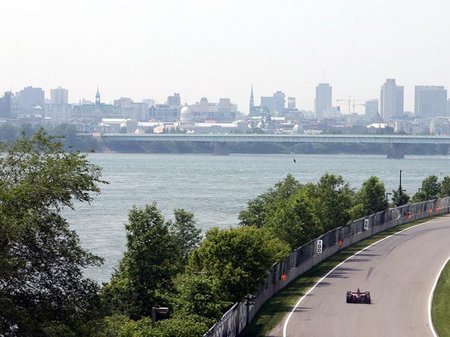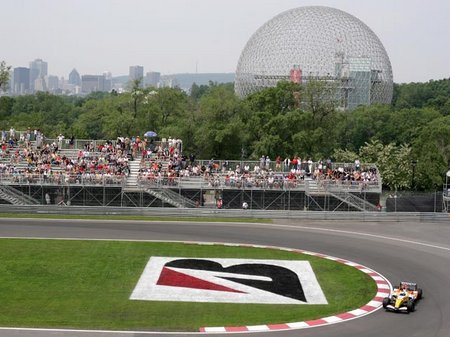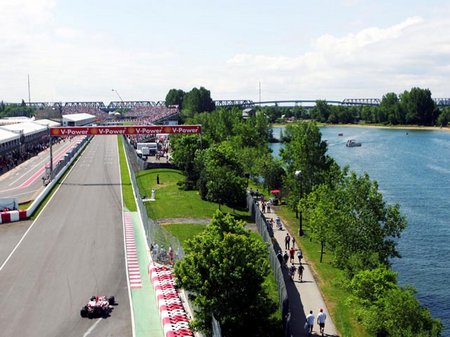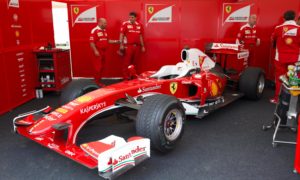
Round seven of the 2008 FIA Formula One World Championship takes the F1 entourage to Montreal for the Canadian Grand Prix. The 70-lap race takes place at the 4.361km (2.710-mile) Circuit Gilles Villeneuve and is the only race on North American soil this year.
The track is located on the Ile Notre Dame, a man-made island in the St Lawrence River that was originally built to house the city’s Expo in 1967. The island subsequently staged the rowing competitions at the 1976 Olympics, before becoming the home of the Canadian Grand Prix in 1978.
The circuit consists of slow corners and six long straights, which encourage the teams to run their cars in low downforce trim. The longest of these straights is a one-kilometre dash between the hairpin at Turn 10 and the final chicane, at the end of which the cars reach a top speed of 324kph (201mph).
Experience the Canadian Grand Prix first hand, enter our ticket store to buy Formula One Practice, Qualifying and Race tickets and passes ( VIP Paddock Club access now available).
LAP OF THE TRACK with Alex Wurz
Montreal is a nice Grand Prix. It feels quite similar to Australia in that everyone likes going there and there is a great city nearby that offers good restaurants and a vibrant atmosphere. I made my F1 debut at this race in 1997, so I associate it with the moment when it all came together for me and I like going back to Canada as a result.
Coming straight after Monaco, the cars feel strange to drive in low-downforce trim. They are always sliding around and you have to get your head around the fact that you rarely find a good balance. Tyre graining is also a big issue.
You arrive at Turn 1 in sixth gear and it’s one of those corners that invites you to brake too late. You want to use the left-hand kerb as much as possible and if you brake too late, the car becomes unstable and the kerb feels much worse than it actually is. This corner leads straight into a first-gear right-hander, which is very slippery early on in the weekend but improves as more rubber goes down.

Turns 3 and 4 make up another chicane and as the track improves you can jump the chicanes and be very aggressive. You run very close to the right-hand barrier at the exit, before positioning the car on the left in preparation for the flat-out right-hander.
The next chicane is quite bumpy under braking, but you can still brake very late and use the kerb on the left. You have to be careful not to unsettle the car because you need to be flat through the right-hander, which is followed by a long straight. Then you go under a bridge and you’re into another chicane, which has only one turn-in point. It’s very easy to miss the entry point here and every year we see drivers getting it wrong and going straight on.
Next comes the hairpin. It is second or third gear, depending on your gear ratios, and it’s very important to have good traction at the exit because the longest straight on the lap follows. You’re flat-out for 15 seconds, before stamping on the brakes for the final chicane. You try to brake later and later into here, but you have to be careful because things can go wrong very quickly. A small mistake and you’ll be in the ‘wall of champions’ before you know it.

The two best overtaking points on the lap are into the hairpin and the last chicane, but it’s not so easy due to the marbles off-line, especially late in the race.
CIRCUIT GILLES VILLENEUVE – THE TECHNICAL CHALLENGE
There are no long corners on the Circuit Gilles Villeneuve. The combination of short, slow corners and chicanes are linked by six long straights, which place an emphasis on high top speeds.
As a result, the cars run in a low downforce set-up for the first time this year and the main engineering focus of the weekend is tyre and brake management. To combat the track’s smooth asphalt, Bridgestone brings its soft and super-soft compounds to the race, as was the case in Monaco, but the heat generated by the centrifugal forces along the straights and under braking make tyre graining an issue.
The circuit is also the hardest of the year on brake wear. The cars slow from seventh to second gear on six occasions during the lap, but the engineers are unwilling to enlarge the size of the brake ducts due to the resultant increase in aerodynamic drag. When you add the strain placed on the gearboxes – there are more gear changes per lap than at Monaco – the 70-lap Canadian Grand Prix is one of the biggest technical challenges of the year.
Full throttle: 74%
Brake wear: Hard Downforce level: Low – 3/10
Tyre compounds: Soft / Super Soft
Tyre usage: High
Average speed: 200kph (124mph)

Q and A with Jenson Button and Rubens Barrichello:
Jenson, What are your hopes for the Canadian Grand Prix weekend?
Montreal is one of my favourite race weekends on the F1 calendar. The atmosphere around the track and the city is always fantastic. The Circuit Gilles Villeneuve is a challenging track which is good fun to drive and completely different from the last race in Monaco. We were not able to achieve much testing specifically for this race due to the poor weather at Paul Ricard, so it is difficult to know how the RA108 will perform until we have the chance to get a few laps under our belt in practice on Friday.
You started from pole position at this race in 2005. What’s the key to a quick lap?
The key to a quick lap is being able to ride the kerbs and you need to have a car which can do this comfortably. You have to be precise because if you hit the kerbs in the wrong place, then you’ll probably end up in the wall. The biggest challenge is getting the last chicane before the pits just right. You can have a perfect lap all the way round but if you hit those kerbs badly, it will throw you off. Getting off the grid cleanly is also important as the first couple of corners are very tight with all 20 cars trying to squeeze through, although you can overtake here if the opportunity presents itself. The hairpin at turn ten is probably the best opportunity for overtaking and where you can see some pretty exciting racing.
Rubens, how much of a relief was it to score your first points of the year in Monaco?
It was very satisfying to score points in Monaco as the car had performed well over the weekend and we deserved a good result from the race. I hope this will be the start of better things to come. This team has a lot of potential and it is important that we all maintain our focus, keep working hard and I am confident that the car will continue to improve over the season.
Will the car feel very different to drive in low downforce specification?
The Montreal track is a complete change from the last race where the tight and twisty streets of Monaco are all about high downforce. For Canada, the car will be set-up in our lowest downforce configuration so far, which means a lower wing level than we have seen this season, and we will spend practice on Friday and Saturday morning tuning the balance and set-up to suit the characteristics of this venue.
Source: Honda








